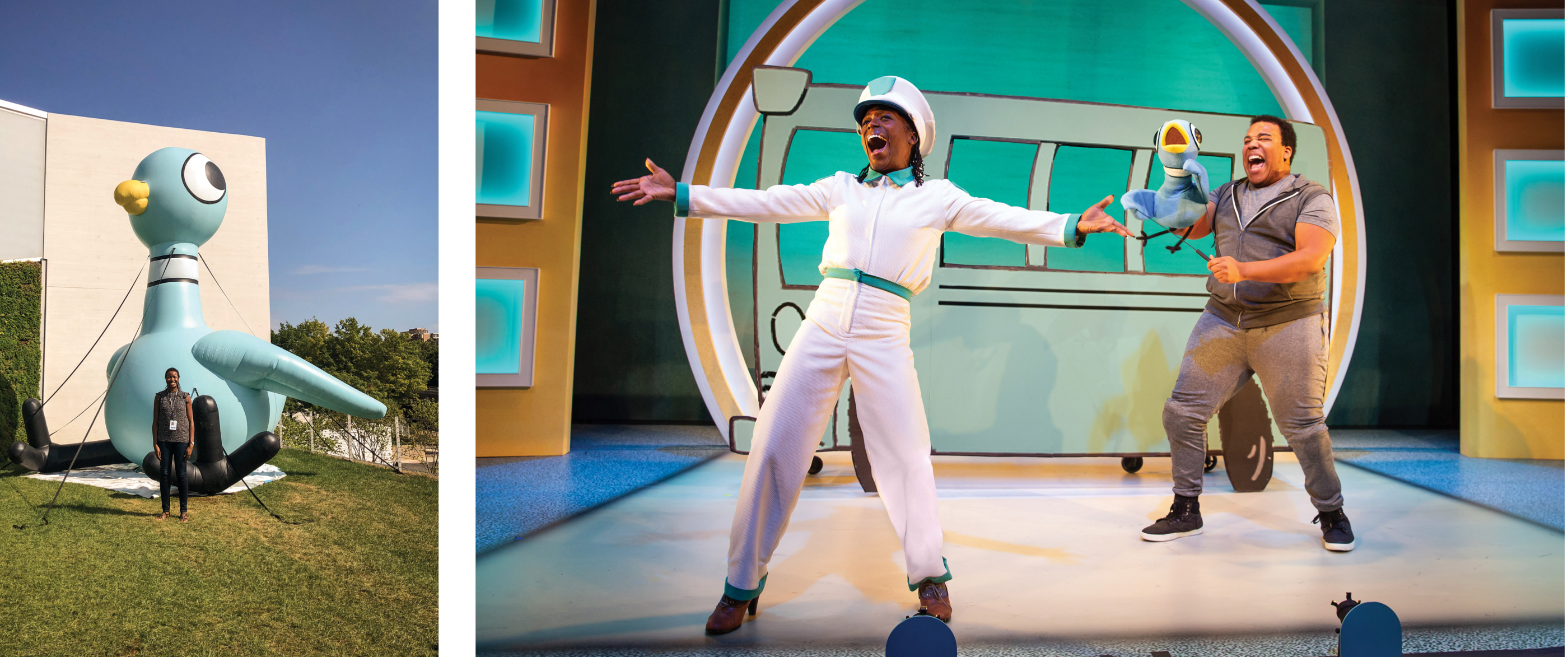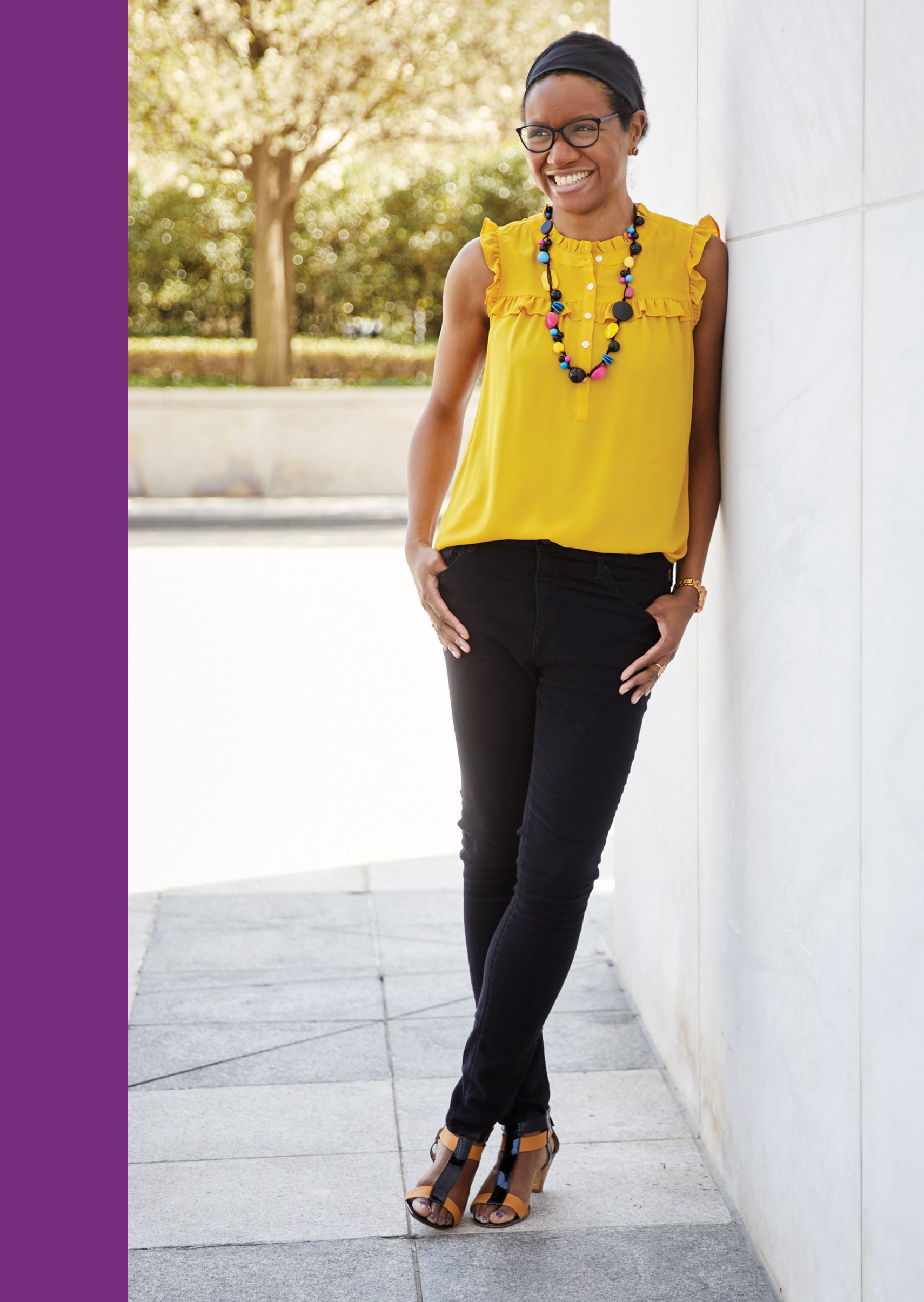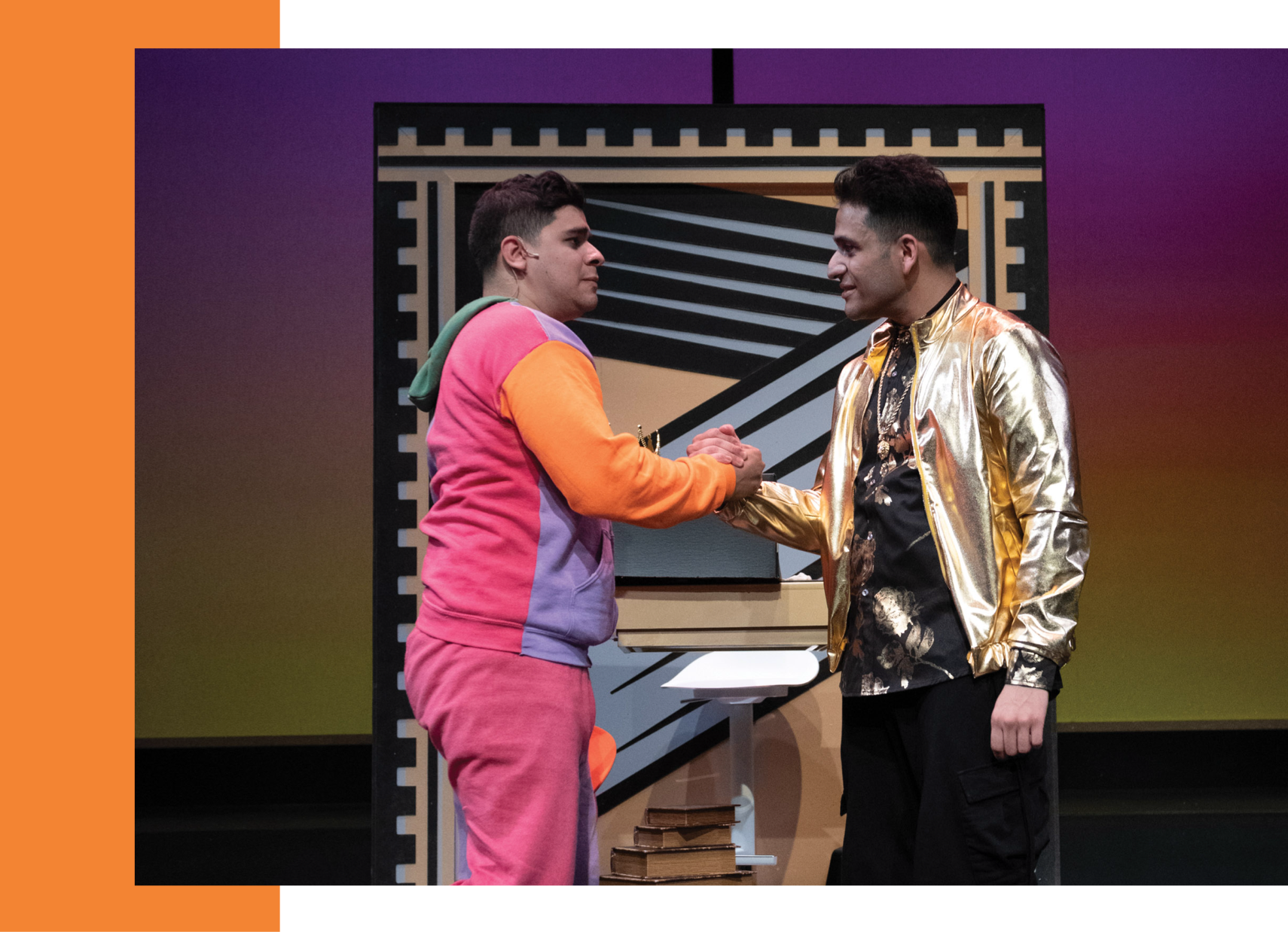Art Gets Us Through
Tiffany Bryant ’07 makes performing arts accessible
June 1, 2021
By
Claire De Lisle M.B.A. ’21
Science is going to get us out of this.
New York Times Best-Selling
In March 2020, the nation closed down as the COVID-19 pandemic took hold. Performance venues from coast to coast shut their doors, unsure of when they would be able to open to the public once again.
Yet, the performing arts did not fall silent. Neighbors sang to and played music for frontline workers as they returned home from long shifts, creating impromptu music in the streets. Barcelona’s Liceu Opera famously livestreamed a concert to an audience of plants that were then donated to local health professionals. Countless artists and venues moved their performances online.
“The arts are especially important right now because they allow us to connect with each other and build gateways of understanding,” says Tiffany Bryant ’07. “We can translate our feelings of mourning or celebration in a way that others, whether in our family or community or across the world, can experience, too.”
Bryant is the assistant manager of audience enrichment for the John F. Kennedy Performing Arts Center in their digital learning department. Established as the National Cultural Center in Washington, D.C., in 1958, the Kennedy Center became a living memorial to President Kennedy after his death in honor of his devotion to advancing the performing arts. Before the pandemic, the center presented over 2,200 shows and events each year.
Then, everything changed.
“During unprecedented moments in history we look to the arts and artists for hope and creative reflections of humanity, but at this time we are not able to gather physically, communally, as we have before for the safety of our artists, staff, and patrons,” Kennedy Center President Deborah Rutter said in a May 4, 2020, press release. “Our staff [are] working to create ... digital resources while actively exploring new ways in which the nation’s cultural center can continue to be a beacon as we look forward to reopening the Center in due time.”
Bryant and her team create these digital resources for teachers, caregivers and students, as well as anyone who wants to access a deeper understanding of the performing arts.
Before the pandemic, Bryant’s work was mostly focused on providing printed and digital resources for teachers and students attending field trips at the center. These “performance guides” would prepare the group by providing context about the program, point out elements to look or listen for during the presentation and then help the group reflect on their experience.
Working at the Kennedy Center meant sometimes accidentally bumping into stars. Bryant remembers crossing paths with Brandy while going to lunch and running into Tony Award-winning Broadway star Bernadette Peters while getting copies from the photocopier — “all types of art were happening all the time and it was always in motion. I miss that about working in the building,” she laments.

As of April 2021, the Kennedy Center is still closed for the pandemic. Its staff collaborates with artists and producers through Kennedy Center @ Home to post videos of performances. Bryant’s team creates supplemental materials, like interviews and learning guides, to enhance viewers’ experiences of educational programs. Being entirely online means people outside of the D.C. Metro area can have access to the Kennedy Center’s resources anytime, from anywhere.
Lesson plans have had to change to adapt to virtual classrooms, hybrid in-person/virtual models as well as caregivers who are teaching their children at home. Bryant works closely with programmers, teachers and parents to meet their needs.
“Unfortunately, arts education is one of the first things cut when budgets shrink, so we offer ways to keep kids engaged in the arts that are quick, fun and accessible, especially with everything parents and teachers have on their plates,” she says.
While some of the materials are available via subscription, others are free for anyone to access.
The resources are designed to be interactive and limit screen time — for example, a teacher or caregiver could watch a five-minute video with their children about how to create a monologue from your favorite fairy tale, and then they could act it out together. Or, for a more physical activity, they could explore yoga storytelling or African dances through online videos and then try it for themselves.
They currently have 67 live lesson plans, with more added on a consistent basis. “Elements of Myth,” for grades 6-8, and “Musical Harlem,” for grades 3-5, are some of their most popular lessons with more than 10,000 views each. Their YouTube channel, Kennedy Center Education Digital Learning, has had over 4 million views over the past year and its subscribers have doubled since the pandemic began.
According to the Brookings Institution, arts education has broad-ranging positive impacts on students’ academic, social and emotional performance. Students who received more arts education had better writing scores on standardized tests, less disciplinary problems and exhibited more empathy than those who received less. Adults who participate in the arts are more likely to be civically engaged and show more tolerance to people different than themselves.
One of Bryant’s favorite performance guides is for “Kid Prince and Pablo,” a bilingual hip-hop adaptation of Mark Twain’s classic novel “The Prince and the Pauper.” The guide she and her team created, available online, provides an overview of hip-hop culture, defines elements of the play like “breaking the fourth wall,” and asks viewers to consider ideas such as oppression, privilege and fairness.
“We want young people to know that the performing arts are more than just watching or listening to something. Young people should be able to see themselves reflected in these experiences,” she says. “Maybe they are going to a ballet show and they think they don’t care about ballet. But if they see all the different elements that come together, or how the story of the ballet is reflected in a book series or a comic book or a video game they know, they can see the meaning behind the performance. Maybe a particular song will make them inspired to go home and translate the feelings they felt listening to that music into music or a poem of their own.”
Through her work and her independent scholarship, Bryant is interested in whose voices are represented through art and whose voices are missing. She is a member of the Popular Culture Association, where as the co-chair of their horror section, she researches representation, identity and intersectionality in horror and other types of popular culture and how they reflect current issues in society — for example, how a zombie film can explore themes of racism. She believes that the way we define “art” as a society should be more inclusive.

“We should be able to look at art, all art, with a similar sense of respect. It’s not that classical music is art with a capital A. There’s something that is inherently problematic about uplifting one art form and denigrating another one just because an art form is considered ‘popular,’” she says. “People tend to write it off because it’s ‘for the masses.’ But it’s something that was created by people. It makes them see the world in a different way, see themselves in a different way, connect with others in a different way.”
Bryant has loved the performing arts and been involved in shaping the education of young people since she was a student at William & Mary. She was a mentor in Project Phoenix, a program that paired W&M students with local middle school students for tutoring, mentoring and field trips to local cultural institutions.
“It’s been a continuing thread for me to be able to work with young folks, and to offer myself as a person whose experience and ideas might help inspire them to see their world and themselves in a different way and grow from that,” she says.
Bryant comes from an Army family. She was born in Germany and then moved to Virginia, where she has lived ever since.
She knew she wanted to stay in state for college and be close to family, but still be far enough away to have an independent experience. When she set foot on William & Mary’s campus, she instantly fell in love. The campus was not only beautiful, but felt like it was the right size for her — at William & Mary she felt like she’d be valued as a person, not just seen as a number.
“I was looking for a school that could allow me to be intellectually challenged, but also get to meet new people and have new experiences, and figure myself out,” she says.
She was also fascinated by American history and keenly aware of William & Mary’s complex past.
“There is the part of me that recognized as a Black student that I would be going to a school that had a history where folks like me couldn’t attend up until a certain point,” she says. “It felt important to be able to do something that those before me couldn’t, and I wanted to be mindful of that. I had a sense coming here that even my own little introverted self could be part of this history and help it become more and more inclusive.”
Singing in the Ebony Expressions gospel choir enabled her to explore her love of performance and connect with multicultural students from all backgrounds. She also found a safe space in the office of Chon Glover M.Ed. ’99, Ed.D. ’06, W&M’s chief diversity officer.
“Being a Black student at a predominantly white institution can involve a complicated intersection of experiences and emotions, and while I have positive memories of W&M, a big reason for that positivity came from access to caring staff like Chon who made sure there were spaces for multicultural collective care and celebration,” she says.
Throughout her life, she’s always been someone “with her nose in a book,” as she put it, so she majored in literature at W&M. After trying a few fields, she minored in literary and cultural studies, which is now called film and media studies.
“One of the great things about being in the humanities is you’re taught to have strong critical thinking and analysis skills, and that there are many ways to interpret something,” she says. “You are always bringing your experiences and insights into the art you are consuming.”
After graduating from James Madison University with her master’s in literature, she worked as an auditor and a substitute teacher, two positions that taught her valuable skills for the work she does today. When she took an internship at the Wolf Trap Foundation for the Performing Arts in their communications and marketing department, she saw a way to work in the performing arts outside of performing — on the administrative and educational side.
Bryant has found herself deep in web design, ensuring the digital learning webpages are easy to use for all these audiences. She’s also doing more of the writing, editing and project managing as the Kennedy Center, like many venues worldwide, implements hiring freezes and budget cuts. It hasn’t been easy — she was furloughed over the summer as the Kennedy Center faced revenue loss of more than $80 million from event and performance cancellations. She’s thankful for the time management and organizational skills she gained at William & Mary for getting her through this challenging time.

In the 10 years she’s worked at the Kennedy Center, she’s shared what she’s learned with current W&M students as a mentor for the W&M Washington Center. The center pairs students studying in Washington, D.C., for a semester with alumni in their field of interest.
Akane Nishimura was a Japanese exchange student at W&M in the spring of 2019 completing an internship at the Kennedy Center through the Washington Center. She says having a supportive alumna there for her was a critical part of her experience.
“Because of her caring and loving personality, I always felt safe around her and she was one of the people who I would have reached out to if I needed any help,” Nishimura says.
Hannah Lowe ’20 was one of Bryant’s mentees as part of the Washington Center’s 2018 Summer Institute in News and Media.
“Her honesty and insight showed me how to make the best use of my time in D.C. and at William & Mary to shape my future career path,” says Lowe. “She also gave me good advice about graduate school and ways to stay involved in research even when pursuing a career outside academia.”
Bryant told Lowe about two of her favorite professors: Arthur Knight, who introduced her to academic scholarship on popular culture, and Francis Tanglao Aguas, who showed her the creative writing side of performance. On Bryant’s advice, Lowe took a class with Tanglao Aguas and asked Knight to be her advisor.
Along with Professor Emeritus Colleen Kennedy, these faculty members showed Bryant how to frame art and literature in approachable ways for diverse audiences, and to consider representation in both the process and the final product. It was in a paper about the movie “28 Days Later” for Knight’s freshman seminar that Bryant first wrote about horror as art.
“Her enthusiasm was so infectious and so deep, and it led her to explore her love of horror in an intellectual way — critically, thoughtfully and in detail. Helping her do her work enriched my understanding of the genre,” says Knight.
“We want our students to be engaged citizens who can look critically at all facets of our society, and Tiffany’s exemplary. It’s wonderful to see her integrating what she learned at W&M, at JMU and in her independent scholarship into her career in educational outreach at the Kennedy Center.”
Now, 10 years later, the world looks a lot different than when Bryant graduated. The pandemic and the Black Lives Matter protests have brought the importance of understanding each other and building community to the forefront. Bryant hopes her work is helping the next generation contextualize and navigate their world through art.
“Regardless of what I’m doing, whether at my day job or through other opportunities related to my creative and academic identities,” she says, “it’s important to me that evidence of diversity, equity, inclusion, accessibility and justice are being acknowledged and activated respectfully and authentically.”